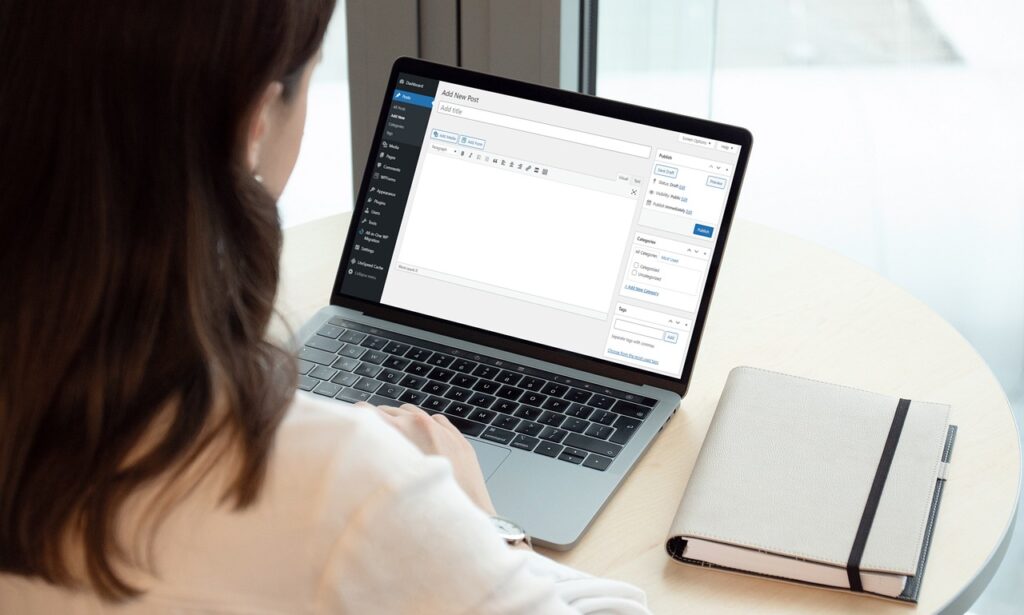Have you ever written a blog post with all your heart? You hoped it would reach many readers but it didn’t. This is a common issue. Many bloggers find that their blogs just don’t get enough views. The key to change this is through SEO. Good SEO can make your content more accessible to a wider audience. It will help more people see what you’ve written.
Blogging is more than just a hobby. It’s a way to get in touch with possible buyers and build a loyal readership. Surveys found that 56% of people bought something after reading a blog. Also, 10% of marketers believe blogging offers the best return for their investment. These numbers show blog SEO’s potential. By improving your blog’s search engine ranking, you can increase traffic and possibly change your blogging success.
Bettering your blog’s SEO goes beyond just good writing. It means doing careful keyword research, coming up with catchy titles, and getting valuable backlinks. It’s also about making your site user-friendly and showing search engines you’re a trustworthy source. Learning and applying these advanced SEO methods will make your blog more visible. It will attract both readers and search engines.
Key Takeaways
- 56% of consumers have made purchases after reading a blog.
- 10% of marketers highlight blogging for high ROI.
- SEO involves keyword research, quality content, and on-page optimization.
- Effective SEO can increase your blog’s visibility and reader engagement.
- It takes between three to six months for a blog post to rank on Google.
What is Blog SEO?
Blog SEO is about making a blog more visible on search engines like Google. It includes choosing the right keywords, getting other websites to link to your blog, and making sure your blog loads fast. A blog that’s well-optimized isn’t just a place to read. It’s a tool that helps people find answers to their questions online.
Definition of Blog SEO
Blog SEO uses special methods to show up more when someone searches online. This includes picking the right words and phrases, creating helpful content, and making the blog easy to navigate. Doing these things helps the blog come up when people are looking for information. It makes the blog a reliable place for anyone interested in the topic.
Importance of SEO for Blogs
SEO is vital for blogs to be seen and trusted. Research shows that with the right SEO, a blog can get over a million visitors a month. Good SEO also makes sure search engines check the blog often. It helps to have well-written content with easy-to-read structure. Short sentences, clear headings, and great images make the reading experience better for visitors. They will stay longer on the blog.
Special tools, like SEMrush’s On Page SEO Checker, can suggest ways to improve. They check the blog for problems and give tips. But, the content must also be easy to read. Blogs need short paragraphs and simple words. If the blog has any technical issues, like not showing up in searches, it could hurt its success. So, fixing these issues is crucial for a blog to do well. Good blog SEO is key to reaching more people and making a mark online.
Blog SEO Strategies
Improving your blog’s SEO is vital for more visitors and better user involvement. We’ll look at essential SEO tactics, focusing on keywords, content, on-page tweaks, and backlinks.
Keyword Research
Choosing the right keywords is key. Use tools like Google’s Keyword Planner and SEMrush. They help find popular topics. This step is critical for making content that matches what users want.
Content Creation and Quality
Creating top-notch content is a must. Your posts should be unique and informative. They should also be easy to read and include important words. By doing this, your posts will grab attention and improve SEO.
Optimizing On-Page Elements
On-page SEO involves meta descriptions and internal links. It also includes using the right headings and alt text for images. These steps make your content easy to navigate. Plus, they help boost your ranking in searches.
Building Backlinks
Getting links from other sites is essential. It shows your content is worthwhile. Working on backlinks raises your site’s worth. It helps with search ranking and draws in more visitors.
- Keyword Research: Using tools to find the best keywords.
- Content Creation: Making content that’s engaging and top-quality.
- On-Page Optimization: Improving your page’s structure and links.
- Backlink Building: Getting good links to your site through various methods.
By following these blog SEO tips, your content will be both impactful and noticed. Your rankings and user interaction will improve.
How can I do SEO for my blog?
SEO for your blog mixes various technical and creative skills. You need to know about meta descriptions, URL formats, and alt texts. But it’s also about crafting content that meets what users and search engines look for.
This means creating catchy titles, using original images, and updating your posts. Doing these things helps keep your blog interesting to readers and search engines.
Starting blog SEO means diving into keyword research. By blogging, you make your website more relevant to what people search for. Did you know, 56% of buyers have found a brand through its blog?
To rank higher, mix main keywords with their related terms. But avoid overusing keywords. Use tools like Coschedule’s Headline Analyzer to craft titles that grab attention. A great title can get a score of 87, showing how important they are.
Linking your blog posts internally helps users and search engines navigate your site. This way, search engines can find and show more of your content. Aim for at least 300 words per blog post. This length is good for both SEO and giving readers solid information.
Don’t forget to keep your blog posts up to date by adding new content regularly. Search engines love fresh content. A good SEO strategy balances creating new content and optimizing it well. This way, your blog stays valuable to readers and search engines. Over time, this effort can increase your blog’s organic visitors and keep them engaged.
Blog SEO Best Practices
Following the best SEO practices for your blog is crucial. It makes your website more visible and keeps your readers interested. By combining careful planning, creative ideas, and ongoing tweaks, you can make your blog stand out in search results.
Identify Target Audience
Knowing your readers well is at the heart of good blog SEO. When you deeply understand who they are and what they like, you can make your content speak directly to them. This smart approach means your blog posts will be more useful and interesting, keeping your audience coming back for more.
Use of Visuals

Using images, videos, and infographics on your blog is crucial for keeping readers interested. Adding alt text to images is important as it helps them show up in search results. Visual elements also make your content easier to read and understand, which keeps visitors on your page longer.
Creating Catchy Titles
Your blog post titles are hugely important. They need to grab attention to get people to click. When making titles, mix powerful, emotional, and unique words. This approach has been proven to increase how much people interact with your content, which is great for SEO.
Internal Linking
Using good internal links helps both your readers and your SEO. By linking new posts to older ones, you can guide readers to more of your content. This strengthens your blog’s structure and helps with SEO. Plus, it makes your website more user-friendly.
Conclusion
Learning blog SEO is key for digital success. A good content plan is crucial for blogs. It includes using the right keywords and making your content easy to read. This helps keep your visitors interested and makes Google like your site more. For major boosts in visitors, moving your blog to a subfolder can help a lot. You might see up to a 98% increase in traffic.
To get more visitors, you need to be careful about how you use links on your site. Having 5 to 10 links in each post can make your site easier to use and help it look better to search engines. It’s also important to keep your URLs short. Research shows that shorter URLs tend to rank higher in search results. Creating a well-organized sitemap for your blog can also make a big difference in how easily search engines find and show your content.
Improving your blog’s SEO is all about linking with your readers. Using the right strategies, like checking Google Trends for popular search terms, can make a big difference. It’s also important to manage your pages well, using things like noindex tags to avoid showing the same content twice. Good SEO isn’t just a one-time thing; it’s about always offering up-to-date, quality content. This makes your blog more popular and helps it stand out in a crowded digital world.

